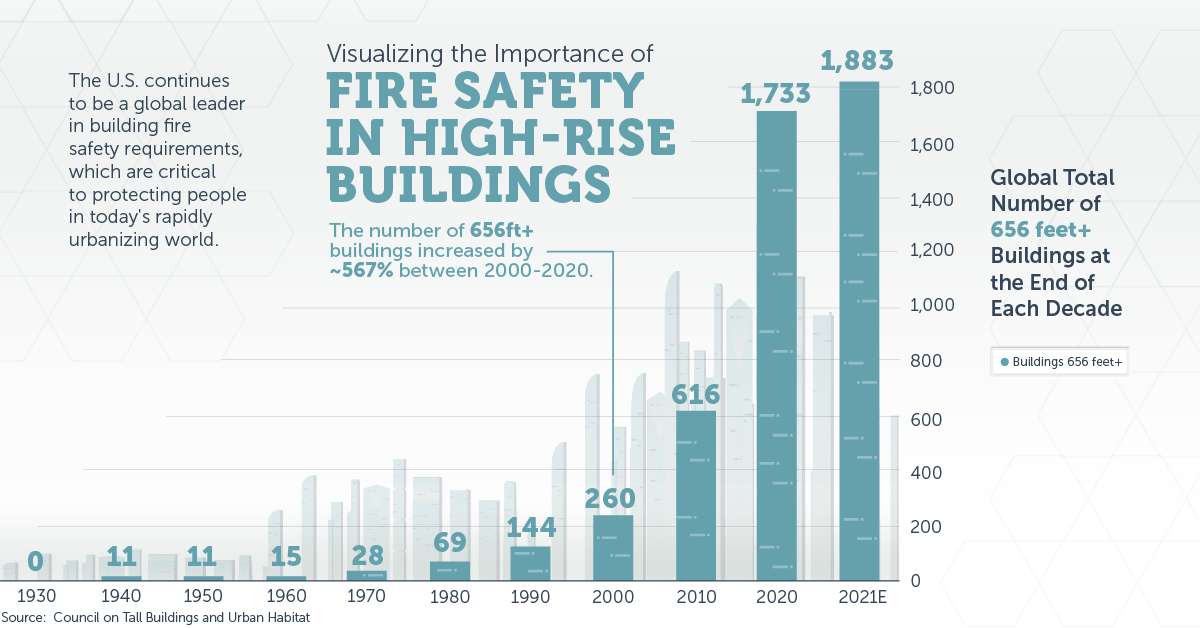Visualizing the Importance of Fire Safety in High-rise Buildings
The following content is sponsored by the North American Modern Building Alliance.

Fire Safety in High-rise Buildings
More than half of the world’s population now lives in urban areas. As a result, tall buildings, which can host a large number of occupants, have become a common feature in modern cities.
Over the last two decades, the global number of buildings taller than 656 feet (200 meters) has increased by 567%, up from 260 in 2000 to 1,733 in 2020. Considering the towering increase of skyscrapers globally, the safety of the people that occupy them is more crucial than ever.
The above infographic from the North American Modern Building Alliance (NAMBA) highlights the need for fire safety in high-rise buildings and shows how the U.S. is leading the way for facade fire testing and safety regulations.
The Importance of Building Fire Safety
With more tall buildings filling the sky, the number of high-rise fires has also risen.
Fire safety is a critical feature of any building, especially for high-rises in densely populated urban areas, for two key reasons:
- Higher number of occupants can slow down evacuation times in the event of a fire
- Fires can spread faster vertically and in smaller spaces
Fires are most dangerous when they cannot be contained, and the structural components of a building play a critical role in limiting the spread of a fire—including its exterior shell, known as the facade.
What is a Facade?
As an integral part of a building’s exterior, the facade not only determines its appearance but also its energy efficiency, fire safety, and weather resistance.
The strength and safety of a facade depend on what materials it’s made of. These can range from stainless steel and aluminum to glass and concrete. A country’s building codes and regulations often influence facade assemblies, and builders in countries with adequate fire safety testing measures are more likely to construct higher-quality facades.
The Leader in High-rise Fire Safety
China, the U.S., and the UAE are the top three nations for number of buildings taller than 656 feet, respectively. Among these, the U.S. stands out with an exceptional fire safety record.
The U.S. is home to 220 buildings taller than 656 feet, but there have been only four high-rise facade fires in the country since 1990, and none since the Monte Carlo Hotel fire in Las Vegas in 2008.
The U.S. record is partly due to facade assembly testing that includes the NFPA 285, a standardized test for flame propagation on or within building exterior walls. The National Fire Protection Association (NFPA) developed the NFPA 285 in the 1980s to ensure that builders use tested and code-compliant facade assemblies, which are safe, secure, and suitable.
The Rising Need for Fire Safety
Our World in Data projects that the world’s urban population will be twice the size of the rural population by 2050. As more people move to cities, skylines will only get taller.
Fire safety will always be a critical component of modern buildings—especially tall buildings that host a large number of occupants. As shown by the U.S., stringent testing, code enforcement, and compliance can be key to improving safety.
-

 Sponsored3 years ago
Sponsored3 years agoMore Than Precious: Silver’s Role in the New Energy Era (Part 3 of 3)
Long known as a precious metal, silver in solar and EV technologies will redefine its role and importance to a greener economy.
-

 Sponsored7 years ago
Sponsored7 years agoThe History and Evolution of the Video Games Market
Everything from Pong to the rise of mobile gaming and AR/VR. Learn about the $100 billion video games market in this giant infographic.
-

 Sponsored8 years ago
Sponsored8 years agoThe Extraordinary Raw Materials in an iPhone 6s
Over 700 million iPhones have now been sold, but the iPhone would not exist if it were not for the raw materials that make the technology...
-

 Sponsored8 years ago
Sponsored8 years agoThe Industrial Internet, and How It’s Revolutionizing Mining
The convergence of the global industrial sector with big data and the internet of things, or the Industrial Internet, will revolutionize how mining works.

